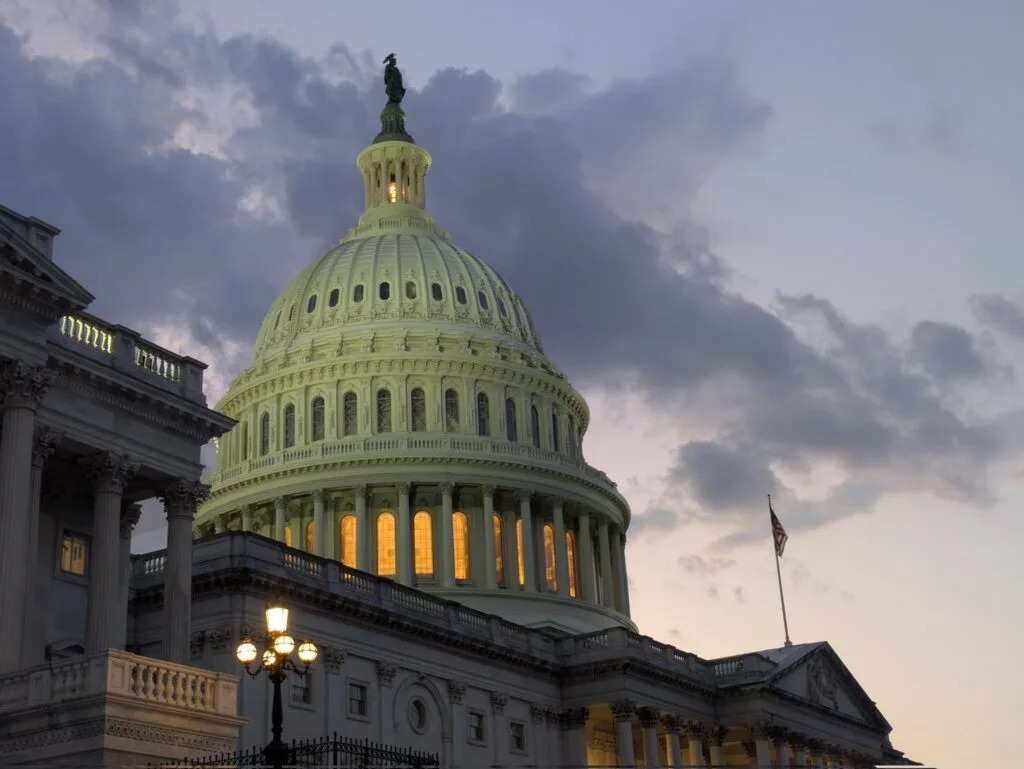
The U.S. Capitol as lawmakers worked into the night on the "big beautiful bill" on July 2, 2025. (Photo by Ashley Murray/States Newsroom)
The Ohio legislature may have finished its work on the state operating budget, but when it returns from summer break, another significant piece of work lies ahead of them.
The congressional map that establishes voting districts for Ohio’s U.S. House representatives must be redrawn before the end of the year. State lawmakers’ first deadline is approaching in September, and maps must be in place for 2026 primary elections.
The process dictated by the Ohio Constitution starts in the legislature. The General Assembly gets first crack at drawing the districts.
According to a legislative brief on the process, each chamber has to come up with agreement from three-fifths of the members to achieve a bipartisan map, including at least half of the Republicans and Democrats in the chambers.
If the legislature can’t come to an agreement, the Ohio Redistricting Commission is reactivated to take over the process.
That commission is made up of the governor, the auditor of state, the secretary of state, and individual lawmakers appointed by the House Speaker, Senate President, Senate Minority Leader, and House Minority Leader.
Ohio Republican politicians currently hold five out of the seven Ohio Redistricting Commission seats.
Both Ohio House Speaker Matt Huffman and Ohio Senate President Rob McColley have sat on the commission previously: Huffman in his former role as Senate President, and McColley as an appointee of Huffman.
The commission has a month to come up with a bipartisan plan. If the commission also can’t come to an agreement, the process returns to the legislature, which then has until Nov. 30 to come up with a map.
If a bipartisan map is agreed upon, that map will last 10 years, but if the commission doesn’t have bipartisan agreement, or if the legislature passes a map by a simple majority vote, the map only lasts for four years.
In comments made to reporters during the budget process in June, Huffman said a positive note for this go-round with congressional redistricting is that the state already has the data, rather than having to wait for a census count to be completed.
He said the procedure that’s spelled out in the state constitution may begin with negotiations as early as August.
“I think there will be some, probably, informal negotiations starting in August with the idea that it may be possible to have a bipartisan bill in September,” Huffman said. “If that doesn’t happen, the redistricting commission will meet in October, and if the commission doesn’t come up with a bill, then in November, the legislature’s required by Nov. 30 to file a redistricting bill.”
A spokesperson for Ohio Senate President McColley said discussions about next steps in the process haven’t started yet in that chamber.
A history of redistricting
The process of redistricting has been a fraught one in the state since the 2020 U.S. Census, which marked 10 years since the last redistricting process.
Redistricting typically happens in line with the decennial census, so that state leaders who draw the maps have the most recent data on population shifts and trends in Ohio.
The layout of the state in redistricting maps should align with the voting trends in the state.
In 2024, President Donald Trump won with 55% of the vote compared to 44% for Democratic nominee Kamala Harris.
Ohio Republican U.S. Sen. Bernie Moreno defeated former Democratic U.S. Sen. Sherrod Brown with 50.09% of the vote compared to 46.47% for Brown.
An average of partisan statewide elections over the last 10 years has Republicans getting 55% of the votes compared to 44% for Democrats.
Currently, Republicans control 66% of Ohio’s U.S. Congressional districts, holding 10 seats compared to five seats held by Democrats.
Moreno has suggested Ohio Republican politicians should draw districts that favor Republicans 12-3, giving them 80% of districts.
During the last round of congressional redistricting in 2021, the two congressional maps that were adopted by Republicans on the Ohio Redistricting Commission were both struck down by a 4-3 bipartisan Ohio Supreme Court majority as unconstiutionally favoring the Republican Party.
At the time of that court, elections for the Ohio Supreme Court were nonpartisan. Republican lawmakers added partisan labels to state supreme court races beginning in 2022. Since then, Republican candidates have swept court races and Republicans now hold Ohio Supreme Court seats 6-1. The remaining Democratic justice on the court, Jennifer Brunner, faces a challenge from Republican Justice Patrick Fischer in 2026.
Even after the second map was struck down by the state’s high court in 2021, however, no changes were made, and the second unconstitutional map remained in place for the 2022 election cycle.
The Ohio Supreme Court will continue to take up all challenges and decide on the constitutionality of the maps this time around.
SUBSCRIBE: GET THE MORNING HEADLINES DELIVERED TO YOUR INBOX
While current Chief Justice Sharon Kennedy was not chief justice at the time, she, DeWine and Fischer all supported the commission-adopted maps, going against the majority court’s decision that the maps were unconstitutional.
Despite his father, Gov. Mike DeWine, sitting on the commission, Justice Pat DeWine did not recuse himself from the redistricting cases.
During the last round of redistricting, then-Chief Justice Maureen O’Connor served as the swing vote on every redistricting decision.
Forced to retire from the court due to age restriction, Connor then went on to join the movement to change the process, serving as a leader in a campaign in 2024 to amend the Ohio Constitution to remove politicians from the process of drawing districts.
Supporters of the measure wanted to see a citizen-led commission drawing the maps and what advocates saw as a more transparent and publicly accountable process.
After Republicans on the Ohio Ballot Board used their positions to write ballot language for the proposal telling voters that the anti-gerrymandering amendment would require gerrymandering, voters rejected the amendment. Many Ohio voters expressed confusion about the issue before, on, and after Election Day.
WEWS’ Morgan Trau contributed to this article.








Comments